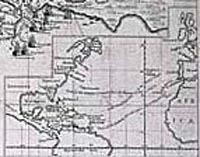The West Indies and the Sugar Trade

In the mid-eighteenth century the island colonies of Bermuda, Barbados, Jamaica, and the four Leeward Islands were the British Empire's most valuable possessions because of the demand for sugar and its by-products, molasses and rum. By the 1770s, West Indian planters were exporting nearly 100,000 tons of sugar and 2 million gallons of rum to Britain and the North American colonies, the combined value of which reached almost £4 million. By comparison, total exports from the Chesapeake colonies, the most valuable on the mainland, came to just over £1 million. The British West Indies were tightly interwoven with the economies and societies of their northern neighbors, especially New England and the middle provinces, as a major market for their exports and supplier of goods that American colonials consumed, processed, and re-exported.
Sugar, like tobacco, depended on slave labor. It also was an "enumerated commodity" that, under the Navigation Acts passed by Parliament, denied West Indian planters direct access to markets outside Great Britain and the other colonies. In return, sugar planters enjoyed a virtual monopoly within the greater British market because their sugar, again like tobacco, was protected from foreign competition by prohibitively high import duties on imports from outside the empire, such as sugar from the French West Indies (which dominated European markets). Consequently, about 85 percent of British West Indian exports were consigned to Britain. The rest were traded to the mainland colonies in exchange for lumber, grain, flour, and salt fish.










